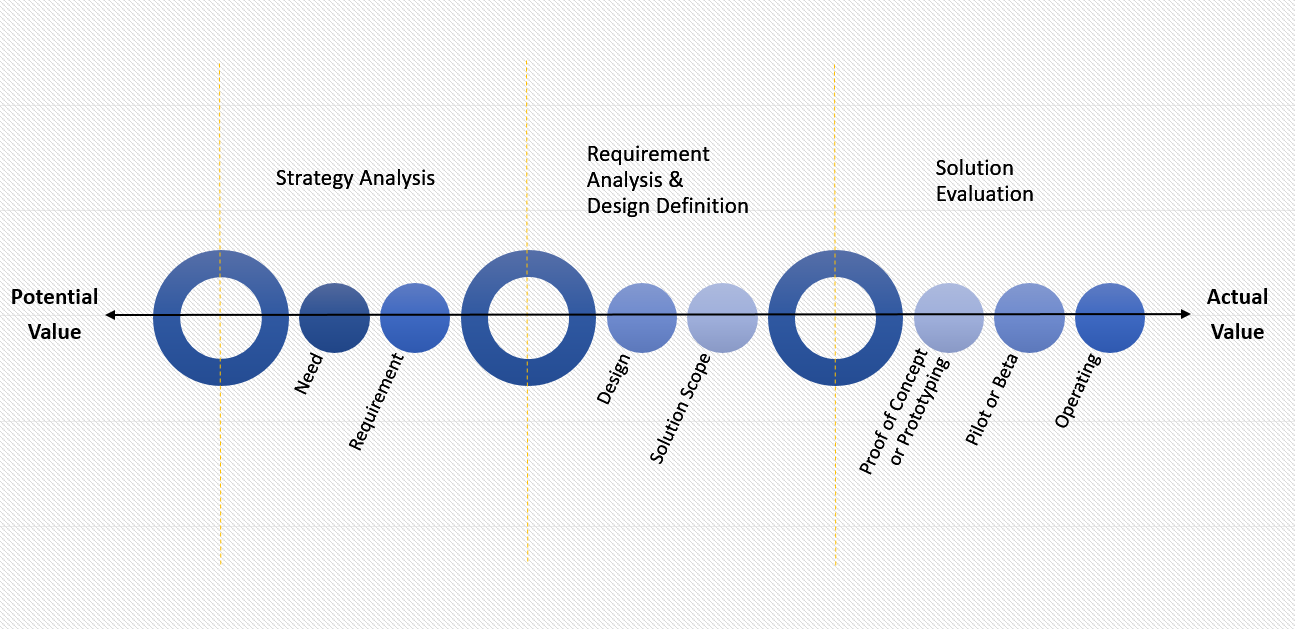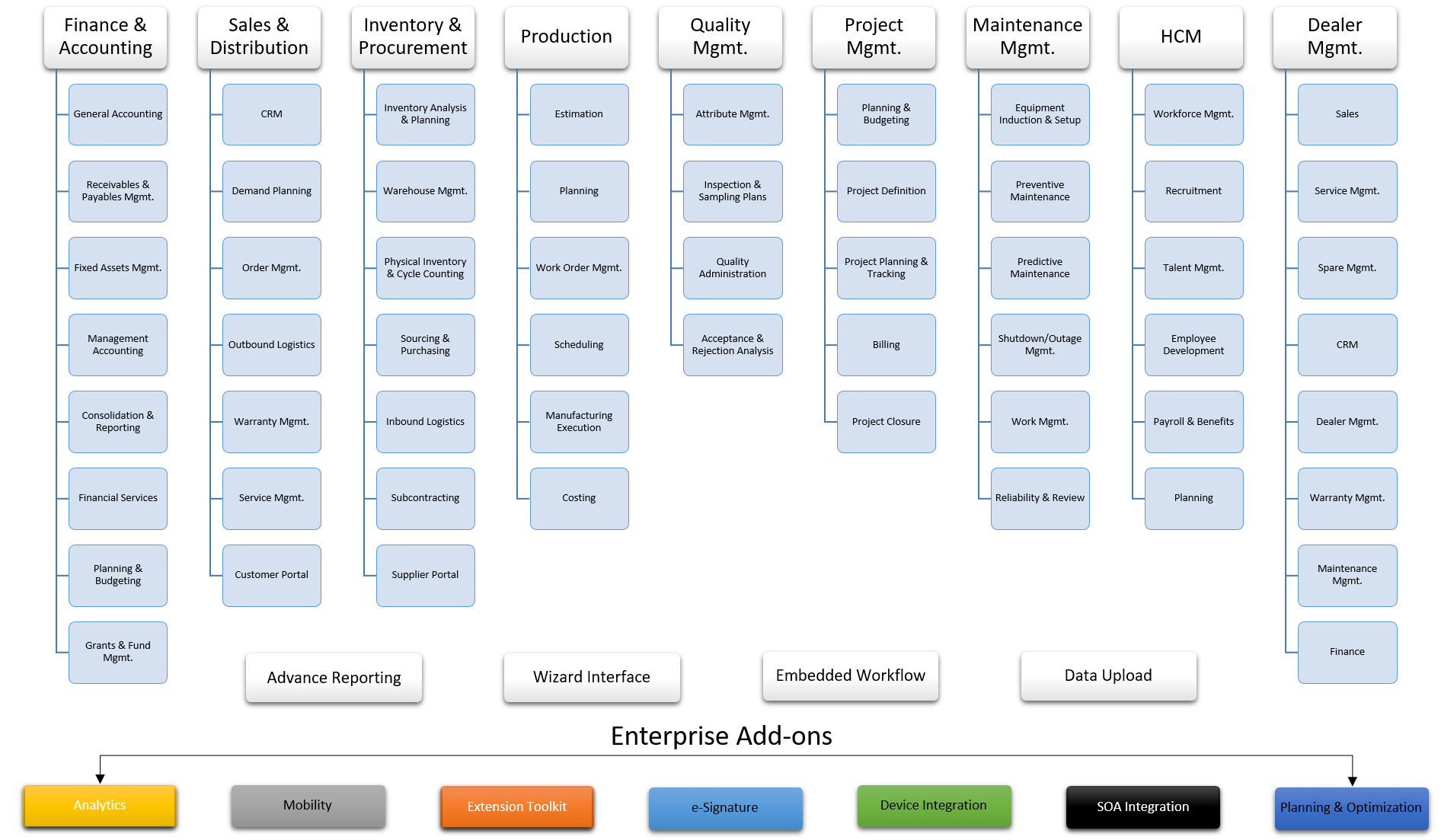Every ERP vendor will walk into our office with their platinum or gold system integrator partner. These sophisticated professionals are typically from sales background and are well trained, multi-lingual & highly equipped with loads of information such as sales presentation, our competition, market trends, their clients, whitepapers etc. Their first question to ask would normally be do you have an IT budget for ERP? rather than asking do you have a requirement architecture in place?. In addition to this - change management, organization readiness, change strategy, analyzing 'as is' processes, defining 'to be' processes, stakeholders list, map or personas etc. are all beyond the boundaries of their scope of work.
I help enterprise to understand or prepare with the pre-requisite that are required before even enrolment for an ERP project. I perform enterprise check upon whether all of our core business processes are well documented or modeled correctly and upto date. Irrespective of whether you are adopting a SaaS or On-premise based ERP implementation, these ERP packages are always delivered in vanila flavour which may require customization as per our business need. Therefore, it is extremely important to first map & document all our business processes which resides in the minds of our process owners. An effective and efficient requirement architecture would drive the entire success story of an ERP implementation project, as it will help in estimating potential value, realizing actual value, negotiations upon licenses, customization of modules to be implemented, selection of right project approach, selection of vendors and on-time delivery of project.
How does it work?
Who is involved?
There are 3 key stakeholders who are involved in taking the ownership roles in ERP implementation.
I perform vendor assessment to determine -
I perform vendor assessment to determine -
- whether any vendors that are part of the current state are adequately meeting commitments, or if any changes are needed
- whether the estimated potential value will be delivered by the vendor
- whether any vendors are part of the change strategy, either to implement the change or to be part of the solution
- if solution is viable and all parties will be able to develop and maintain a healty working relationships
- which of the vendor performance measures should be included in the solution's performance assessment

Core Committee
Define the enterprise level vision and mission statments, budget and KPIs. Enforce change management. Decision making. Appoint operational committee members & their respective KRAs. Provide feedback.

Operational Committee
Provide access to the existing organizational business processes - workflows, charts, reports, SOP, business process models etc. Highlight upon existing pain areas and stakeholders wish list. Work on KPIs. Provide feedback.

Vendors
Ensure that all the business needs of an enterprise are understood correctly. Active involvement in workshops or interviews with operational committee. Submit business proposal along with project implementation approach (e.g. Sure Step or ASAP).

Management Consultant
Bridging the gap between business and vendors. Analyze current state. Define future state. Analyze risk. Define Change Strategy. Develop requirement architecture and execution of acceptance & evaluation criteria technique for shortlisting right vendor.
Business Analysis Value Spectrum

Above diagram illustrates the spectrum of value as business analysis activities progress from delivering potential value to actual value. I work very closely across the board to devise an estimation for the potential value of the solution. In addition to this, I will touch base all the three core knowledge areas of business analysis i.e. strategy analysis, requirement analysis and design definition & solution evaluation. The end objective here is to achieve an actual value with a very less or zero variance.
- 1. Strategy Analysis: collaboration with stakeholders in order to identify a need of strategic or tactical importance, enable the enterprise to address those needs and align the resulting strategy for the change with higher and lower-strategies
- 2. Requirement Analysis and Design Definition: An iterative and incremental activities performed ranging from initial concept to the exploration of the needs through the transformation of those needs into a particular recommended solution
- 3. Solution Evaluation: Assess the performance of and value delivered by solution in use by enterprise, and to recommend removal of barriers or constraints the prevent the full realization of the vale
Traditional Methodology
I perform business capability analysis to check if an enterprise has strong ERP competency, and if the majority of the team members do possess an ERP implementation experience (within 5 years). In such scenario, we can go ahead with the traditional model which includes -
Advantages - Customer lead process - The customer takes responsibility for the project. Requires less vendor consulting support. Puts responsibility on the business team to understand the system. Requires the customer to gain self-sufficiency in knowledge and use of the ERP system.
Disadvantages - Requires a high level of ERP competency within the customer team. Requires a greater commitment of time from the customer team.
- 1. Planning: The project managers (customer and vendor) work together to form the ERP implementation team, and plan the project based on the right ERP implementation methodology for the project scope and available resources. A kickoff meeting involves the entire team to review the project plan and communicate the company objectives for the project
- 2. Education: The vendor consultants educate the implementation team. In this methodology, this is a very important step. Most advocates of this methodology believe the education of the core team is the key to the customer’s self-sufficiency and a successful project
- 3. Design / Configuration: The consultants assist the implementation team in designing, configuring and setting up the new system and business processes. The vendor consultants support the implementation team, and the team does the work
- 4. Conference Room Pilot: The implementation team tests the system in multiple Conference Room Pilots (CRP). The final CRP becomes a simulated go-live. At the end of the phase, the system is accepted by the team as ready to go live. The vendor consultants support the team’s effort. By the end of this phase, the customer team has established a complete understanding of the new system.
- 5. Cutover Activities: The implementation team plans the cutover process and trains the rest of the end-users on the new system. The implementation team performs the training, and the vendor consultants support the team
- 6. Go-Live Support: The implementation team supports the end-user in the use of the new system. The implementation team provides real-time support. The vendor consultants are also on-site during the first month to support the quick resolution of new problems as they arise.
Disadvantages - Requires a high level of ERP competency within the customer team. Requires a greater commitment of time from the customer team.
Turnkey Methodology
If your company does not have experienced ERP users and the users have been using an older legacy system for many years, the turnkey model may be your best choice. This model is also attractive to companies that have downsized and have lean staff that may struggle with the added burden of implementing a new ERP system. In such scenario, we can go ahead with the turnkey model which includes -
Advantages - Can yield a faster implementation path (16 weeks compared to 26 to 40 weeks). Company must adopt vendor’s best practice processes.
Disadvantages - The total cost of ownership will be higher over time. Can result in higher ongoing support costs. Puts responsibility on the vendor consultants to learn the customer’s business. The customer places a greater reliance on the vendor for a successful implementation.
- 1. Planning: The activities are the same in this phase as the traditional methodology, with the vendor consultant taking a bigger role in the construction of the plan. Also, the vendor project manager is planning the vendor consultant's time since they are involved full-time in the next four phases of the project
- 2. Discovery / Set-up / Configuration: In this phase, the vendor consultants review the current process, design/configure/setup new processes, and perform an initial test with minimal involvement of the customer team. The customer implementation team is only involved in discovery by providing input on current processes. In essence, the vendor team is providing a turnkey approach to system design and the setup of the new system.
- 3. Prototype Review / Education: In this phase, the vendor team delivers the new system to the customer implementation team and begins to educate the customer team through prototype demonstration workshops. In these reviews, the customer team is getting educated on the new system and the capabilities of the product. The vendor team identifies issues and adjusts the new system as needed. At the end of this phase, the customer team accepts the design of the new system.
- 4. Conference Room Pilot: In this phase, the vendor team leads the customer team through several phases of a conference room pilot (CRP). The last CRP becomes a simulated go-live. When this CRP is completed, the customer team accepts the new system and is ready to go live
- 5. Cutover Activities: The implementation team plans the cutover process, and trains the rest of the end-users on the new system. The implementation team performs the training and the vendor consultants support the team
- 6. Go-Live Support: The implementation team supports the end-user in the use of the new system. The implementation team provides real-time support. The vendor consultants are also on-site during the first month to support the quick resolution of new problems as they arise
Disadvantages - The total cost of ownership will be higher over time. Can result in higher ongoing support costs. Puts responsibility on the vendor consultants to learn the customer’s business. The customer places a greater reliance on the vendor for a successful implementation.
If this sounds like your business case then,
The best thing to do is call to action. There is no hard sell in this matter. Either I can help you or I can’t and it is pretty easy to tell both ways. If I am not the right person, I can usually suggest someone who might be.

